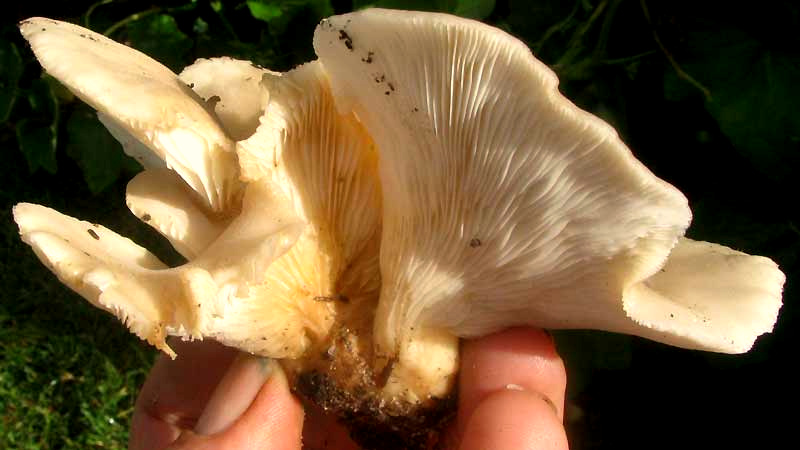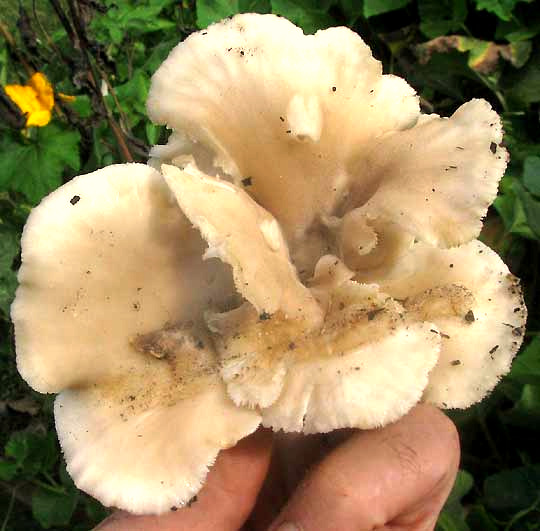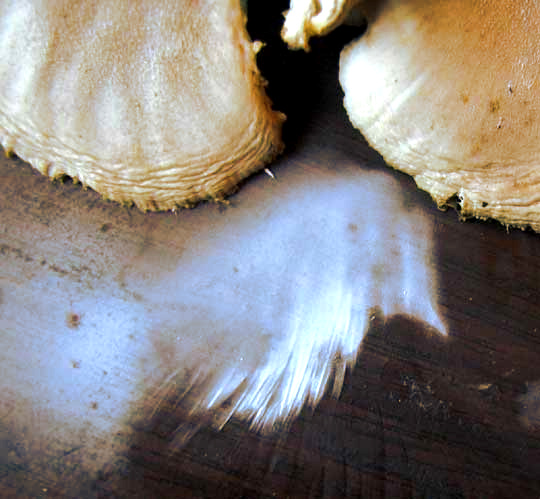Excerpts from Jim Conrad's
Naturalist Newsletter

from the October 13, 2013 Newsletter issued from the Frio Canyon Nature Education Center in the valley of the Dry Frio River in northern Uvalde County, southwestern Texas, on the southern border of the Edwards Plateau; elevation ~1750m (~5750 ft); N29.62°, W99.86°; USA
OYSTER MUSHROOM
It's so arid here that we don't see many fleshy mushrooms. However, a good one turned up in the yard of my neighbor Phred, where he waters his pumpkins once or twice a day. The mushrooms grew in a cluster on a tree stump in the shade of big pumpkin leaves. Phred collected the mushrooms and handed them to me before I could get a picture, so, above, you can see what they looked like in my hand. Notice how the gills on the caps' bottom surfaces extend onto the thick stems. A shot from above showing the caps' brownish blush is shown below:

This is one of the most common, easy-to-identify and best known of all mushrooms in North America and northern Eurasia, the Oyster Mushroom, PLEUROTUS OSTREATUS.
When I was a kid, because Oyster Mushrooms are so easy to identify, they were the first wild mushrooms I had enough nerve to eat. Once I'd nibbled one to be absolutely sure I wasn't going to die, I ate a little more, and when nothing happened, then I went pig wild. On our farm we had several dying cottonwood trees whose trunks were loaded with them. I'd melt a dollop of butter in a big skillet, cover the skillet's bottom with Oyster Mushrooms, then once everything was well fried I'd sprinkle on salt and pepper, and that was some of the most memorable eating of my life.
Actually, there's a good chance that what I ate wasn't the real Oyster Mushroom. That's because nowadays they've realized that what we've always thought of as one big, variable species actually consists of several. Happily, all the species can properly be called Oyster Mushrooms, and all are edible. One of the other species, Pleurotus populinus, specializes on growing on poplars, and cottonwoods are poplars. That looks like the "real" Oyster Mushroom in our picture.
Oyster Mushrooms live both on dead trees and logs, where they're "saprobic," and on living trees, in which case they are parasitic, and cause a white rot disease. Curiously, Oyster Mushrooms kill nematodes and bacteria in the rotting wood they live in.
I placed Phred's mushrooms on a table for a few hours before chopping them into an omelet. During that time, white spores fell from gills beneath the cap onto the dark table top. Below, you can see the resulting accidental "spore print":

Often when identifying mushrooms I make spore prints to see what color they are, for some species produce black spores while others may produce gray or green ones, or spores of other colors. You can see that Oyster Mushrooms produce white spores.